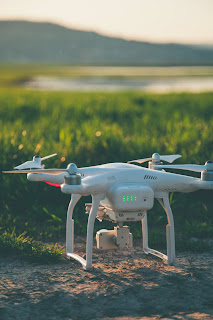Robotics :
In recent years, robotics has emerged as one of the most exciting and rapidly evolving fields of technology. From autonomous vehicles to robot-assisted surgery, robotics is changing the way we live and work. However, one of the most interesting aspects of robotics is how it is being used to solve unique and challenging problems that were previously impossible to tackle.
 |
| Robot |
One such problem is the challenge of inspecting and maintaining large structures such as bridges and skyscrapers. Traditionally, inspecting these structures involved sending human inspectors to climb up and visually inspect the structure, which was not only dangerous but also time-consuming and expensive. However, robotics has provided a solution to this problem in the form of drones and climbing robots.
Drones equipped with cameras and sensors can fly around structures, capturing high-resolution images and data that can be used to assess the structure's condition. In addition, drones can also be equipped with tools and sensors for inspection and maintenance tasks, such as spraying coatings or testing for structural defects.
 |
| Drones |
Climbing robots, on the other hand, are designed to climb up and down vertical surfaces, such as building facades or bridge supports, to perform inspection and maintenance tasks. These robots are equipped with sensors and cameras that can detect defects, and they can also carry tools for repairs and maintenance.
Another area where robotics is making a significant impact is in agriculture. With the world's population projected to reach 9.7 billion by 2050, there is a growing need to produce more food in a sustainable and efficient manner. Robotics is helping to achieve this goal by providing solutions for precision agriculture.
Precision agriculture involves using data and technology to optimize crop yields while minimizing waste and environmental impact. Robots can be used for a variety of tasks in precision agriculture, such as planting, harvesting, and monitoring crops. For example, robots can be equipped with sensors and cameras that can detect crop health and growth, allowing farmers to make informed decisions about when to harvest or apply fertilizers and pesticides.
Finally, robotics is also being used to address environmental challenges, such as cleaning up oceans and rivers. Robots can be designed to collect and remove waste and debris from waterways, reducing the environmental impact of plastic pollution and other waste materials.
In conclusion, robotics is a field with enormous potential for solving unique and challenging problems in a wide range of industries and applications. From inspecting and maintaining large structures to precision agriculture and environmental cleanup, robotics is revolutionizing the way we approach complex problems, making our world safer, more sustainable, and more efficient.
Advantages of Robotics:
Increased efficiency:
Robots are designed to perform tasks with high speed and accuracy, which can lead to increased efficiency in production and manufacturing processes.
Reduced labor costs:
Robots can perform tasks that would otherwise require human labor, reducing labor costs for businesses.
Improved safety:
Robots can be used to perform tasks that are dangerous or hazardous for humans, reducing the risk of workplace injuries.
Consistency and reliability:
Robots can perform tasks with a high degree of consistency and reliability, ensuring that products and processes meet consistent quality standards.
Increased productivity:
Robots can work around the clock, without breaks or interruptions, which can lead to increased productivity and output.
Disadvantages of Robotics:
High initial costs: The development and implementation of robotics systems can be expensive, requiring significant upfront investments.
Limited adaptability:
Robots are designed to perform specific tasks and may not be able to adapt to changes in the production process or new tasks without significant reprogramming or retooling.
Job displacement:
The use of robots can lead to job displacement, particularly in industries where robots can replace human labor.
Maintenance and repair:
Robots require regular maintenance and repair, which can be costly and time-consuming.
Ethical and social concerns:
The use of robots raises ethical and social concerns, particularly around issues such as privacy, security, and the impact on employment.


0 Comments